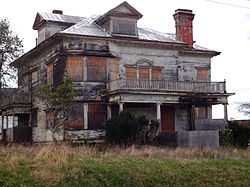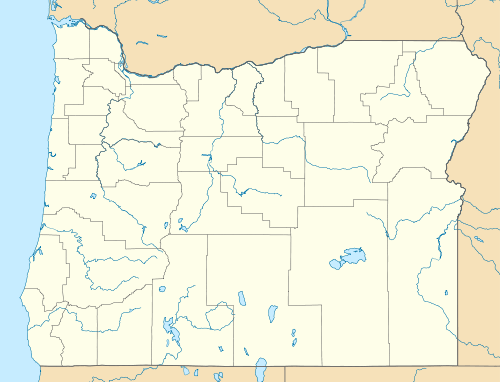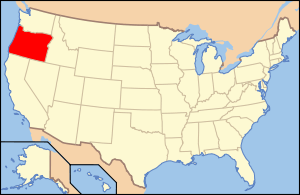Captain George Conrad Flavel House
|
Captain George Conrad Flavel House | |
 | |
|
The house in 2014, boarded-up by the city under a derelict-buildings ordinance | |
 | |
| Location |
627 Fifteenth St., Astoria, Oregon |
|---|---|
| Coordinates | 46°11′12″N 123°49′39″W / 46.18678056°N 123.8273667°WCoordinates: 46°11′12″N 123°49′39″W / 46.18678056°N 123.8273667°W |
| Built | 1901[1][2] |
| Built by | Joseph W. Suprenant[1] |
| Architectural style | Colonial Revival, Queen Anne |
| Governing body | Private |
| Part of | Shively–McClure Historic District (#05000829) |
| NRHP Reference # | 86001222[3] |
| Added to NRHP | June 5, 1986[1] |
The Captain George Conrad Flavel House is a house built in 1901 in Astoria, Oregon. It was listed on the National Register of Historic Places in 1986.[1][2]
History
The house was built by Joseph W. Suprenant, but the identity of the architect is unknown.[1] The Colonial Revival-style house was the second residence of Captain George Conrad Flavel (1855–1923), his wife Winona and their son Harry, after they moved to it in 1901 from their first home, an 1879-built, smaller and more plain house that is also listed on the National Register, as the George C. and Winona Flavel House.[4] George Conrad Flavel was the son of George Flavel (1824–1893), also a captain. George Conrad Flavel lived in the house until his death in 1923, and Winona Callendar Flavel (1861–1944) continued to reside there until her death in 1944. Harry M. Flavel (1886–1951[4] or 1886–1957[1]) lived in this house as a child and then again from 1924 – after inheriting it from his father – until his death[1] (in 1951[4] or 1957[1]).
After Harry Flavel's death, his wife, Florence (née Sherman) and their two children, Mary Louise and Harry S.,[5] were the only residents of the house. In 1947, Harry S., at age 20, attacked a neighbor with a hatchet,[5] and the family became known as recluses in the community after the incident. In 1983, Harry S. was imprisoned after hitting a man's car with a chain one evening and then stabbing him.[5] After serving seven years of his sentence, Harry S. was released from prison in 1990, and the Flavel family disappeared from the house shortly after. The home remained uninhabited and derelict for over twenty years until the city of Astoria took control of the property, acting under a derelict-buildings ordinance passed in 2011.[6] The city then proceeded to board-up the house and carry out an inspection. Foreclosure proceedings followed in late 2013.[7]
See also
- Capt. George Flavel House and Carriage House, 441 Eighth Street, Astoria, a house museum, also NRHP-listed
- George C. and Winona Flavel House, 818 Grand Ave., Astoria, also NRHP-listed
References
- ↑ 1.0 1.1 1.2 1.3 1.4 1.5 1.6 1.7 Tetlow, Roger T. (June 15, 1985). "National Register of Historic Places Inventory–Nomination Form: Captain George Conrad Flavel House" (PDF). National Park Service. Retrieved July 25, 2012.
- ↑ 2.0 2.1 "Oregon National Register List" (PDF). Oregon Parks and Recreation Department. June 6, 2011. p. 5. Retrieved July 23, 2012.
- ↑ "National Register Information System". National Register of Historic Places. National Park Service. 2008-04-15.
- ↑ 4.0 4.1 4.2 Goodenberger, John E. and Bonnie Susan Oathes (July 29, 1990). "National Register of Historic Places Registration Form: George C. and Winona Flavel House" (PDF). National Park Service. Retrieved July 25, 2012.
- ↑ 5.0 5.1 5.2 Gorrow, Chelsea (2012-07-03). "Flavel family mystery unsealed". The Daily Astorian. Retrieved 2014-03-28.
- ↑ Staff writer (July 8, 2012). "Astoria takes charge of disheveled Flavel mansion". The Oregonian. Associated Press. Retrieved December 26, 2013.
- ↑ Staff writer (December 23, 2013). "Astoria foreclosure case offers history, fines, frozen dog". The Oregonian. Associated Press. p. A5. Retrieved December 26, 2013.
| Wikimedia Commons has media related to Captain George Conrad Flavel House. |

